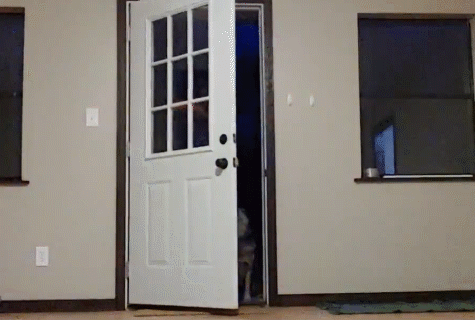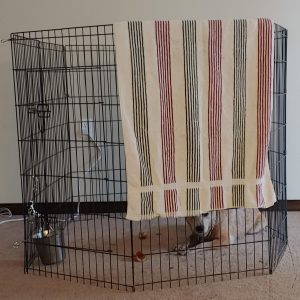Hi, y’all. Last time, I talked about ways to tire your dog out so that he doesn’t cause you problems out of boredom. Today, I’d like to talk about starting to train your dog to be a contented member of your household, even if you don’t have much time for them and strangers constantly come and go. Here are a few ideas that have worked for me and others to train without training sessions.
Mix and Match
One of the nice things about the techniques I shared last time is that often they involve big treats that the dogs really love. And one of the few advantages from a training perspective of trying to care for an elderly relative is that visitors are usually scheduled in advance. So I make sure to have my dogs’ meals stuffed into Kongs and frozen when I’m expecting people to come help with her care and treatment.
When someone arrives, I quickly whip out the Kongs and hand them to the dogs in my laundry room, which is behind a baby gate. This means that my dogs just expect that when someone comes to the door they will be richly rewarded for hanging out in the laundry room. I take the giant treat I was going to give anyway and get triple value from it—they are happy to see visitors, they run eagerly into the laundry room when visitors arrive, and it gives them a little mental exercise to tire them. Then they work quietly on their Kongs for a while as I do whatever needs to be done with the visitor. You can use a crate or an exercise pen if you don’t have a handy room that’s gated off for your dogs.
Note: it can be tempting to give the Kong out before the visitor arrives just so the dog is already busy when the visitor comes in. I avoid doing this even if I get a bark or two when the visitor knocks.
There are two reasons for this. First, visitors have a way of not knowing or caring what you’re doing with the dog, and they could take longer than expected to get to the point of knocking. If this happens, your dog could finish with the chew before the visitor gets in. The second reason is that part of the strategy here is to convince your dog that when visitors arrive, he’ll get a terrific treat. If the dog already has the treat when the visitor arrives, it just won’t have the same impact.
Collar Grab
To me, one of the most important things to teach a dog is to allow you to easily get hold of its collar. Or even to run to you and place its collar in your hand. I can’t tell you how many times my dogs were on the verge of running amok and this saved my bacon. I may go more into depth on teaching that kind of collar grab later, but I want to talk about how you can get a long way toward a basic collar grab while spending almost zero time on it.
The first tip is one I learned from my mentor, Susan Garrett. Whenever you are giving your dog a treat anyway, grab the collar right before you give the treat. Note that if your dog is already suspicious of having his collar grabbed, you might need to just hold your hand near the collar at first and work your way up to grabbing the collar over a few days.

Another thing you can do is to keep treats near the door you use most often to go on walks with your dog. When you remove the leash, you have to grab the collar anyway, so just take a moment to give a treat while your hand is still on the collar and before you let the dog go on to do whatever dog things he had in mind. I like to do this, because the dog gets to be as excited about coming into the house as leaving the house. If your dog ever does get out off leash, you have a better chance of getting him back, whether that’s through being able to grab his collar or just opening the door where he knows a treat is waiting.
And, of course, you can “mix and match” with collar grab as well. Just add a step after the dog runs to where you are going to give him a stuffed Kong where you grab his collar before handing him the Kong.
Self Training
One of my favorite things to do is just set things up so the dog trains herself. I first came across this concept reading about how Austerlitz Shepherds starts crate training their puppies by positioning the crates where the puppies have to go into them to be near the activity in the room.
I’ve used this concept a number of times, but recently I had a situation where my dog Arya would try to get attention from my mom by jumping on her. Mom didn’t take kindly to that, and in the current state of her illness I couldn’t tell her to just ignore Arya and let me handle it. Instead, she’d shove Arya back, resulting in a vicious cycle where Arya and Mom were starting to dislike each other.

So I came up with this setup. It has several benefits. The first is that it completely prevented Arya from seeking attention from my mother. In my opinion, about 80% of dog training is just making sure your dog isn’t able to do the wrong thing.
We did start getting a new wrong thing, though, because of the bad relationship between my mom and Arya. Arya would stare at my mother until she was upset, and then she would bark (Arya, not my mother). So I added a strategically-placed towel to help her realize that she could stop looking at something that was bothering her to see.
This towel is hung so she can see my mom if she stands way to one side or if she lies down. To stay in one of those positions, she needs to be calm and in control of herself. As soon as she starts barking, she also starts moving—and she’ll move right out of the position she needs to stay in to see my mom, breaking her eye contact and calming her down.
SMART x 50
When we’re under stress and our dogs are part of that, it’s easy not to notice all the times the dog isn’t adding to our stress. What if it were possible to increase the percentage of time the dog is behaving perfectly fine and decrease the amount of time the dog spends doing things we’d rather he didn’t?

Note that the above is an Amazon affiliate link, so if you buy the book, I could get money. But that’s not why I recommend it :).
This is the concept outlined Kathy Sdao’s Plenty in Life is Free as SMART x 50. This stands for
See the behavior you want
Mark that behavior (using a clicker or special word)
And
Reward that behavior (using food, in this case)
Times 50
The way it works is you count out 50 treats in the morning and try to catch your dog doing things right so many times throughout the day that you use them all up.
I tend to be pretty relaxed about the 50 treats part. Instead, when my dogs are puppies, I’ll measure out their next meal and leave it in a bowl somewhere handy. Will you judge me if I say that’s often the kitchen table? Then, I will mark and usually go back to the bowl to give out the reward. But sometimes I load a few in my pockets for when we’re outside or at the opposite end of the house. When it comes time for the next meal, if there’s any left I feed that to the dog all at once.
I love lots of things about this method. First, it reminds me to appreciate all the times my dogs really are being good. Next, it takes basically no time, but really helps me see big changes in my dogs’ behavior. Finally, it’s a great way to prevent the problem where dogs won’t work when they think you don’t have treats on you. Because often I have treats on me, but I’m not training and don’t give them out, and when I do get them out they come from a bowl on the table.
Recapture Time
I listen to lots of podcasts when I’m driving around, and Michelle Stern of Pooch Parenting suggests that new parents who are having a hard time finding time make a point of filling in “wasted time” with dog training. For example, if your coffee or tea has gotten cold, you might pick up some treats and train your dog while you’re reheating it in the microwave. I personally find that I’ve already booked out these times for tasks that are easier to do in the moment, such as putting away clean dishes, but it might be helpful for some readers.
Speaking of time, next time, I’ll talk about some simple things you can train your dog to do that will make your life with them even easier and more fun, so stay tuned!

